 Now, to refresh our memories, here is the photo of the first round on the muslin for the jacket. There are a number of issues here and, starting from the top, we’ll review:
Now, to refresh our memories, here is the photo of the first round on the muslin for the jacket. There are a number of issues here and, starting from the top, we’ll review:
Shoulders: The shoulder seam is too long; it’s hanging out over the shoulder joint. That needs to be shortened.
Armscye: There are two issues here – one which we can see in this photo and one which we can’t (you’ll have to take my word on this one). The first one, which you can see, is the flap of fabric hanging out there. This is caused because a) I’m short, so the distance between my shoulders and my bust point is shorter than it would be if I were the height of an ‘average’ woman wearing this particular size. This is a problem I have…every…single…time. Just part of the game and has to be dealt with. If the amount of extra stuff there was less than 1″ (that is, if I pinched the extra together and it was like a dart that was 1/2″ on each side), then what I’d do is I’d frankly…cheat. I’d ease-stitch around the entire length of the front part of the armscye and ‘eat up’ the extra that way. This, however, is NOT 1″. This is like 2″, so (sigh), I can’t cheat. I have to find a way to reduce that distance. There are multiple ways to doing this, and in my case, I’m going to do a combination of things. (more…)
Uncategorized
Make a muslin month: Fixing the front
When do I transplant seedlings?
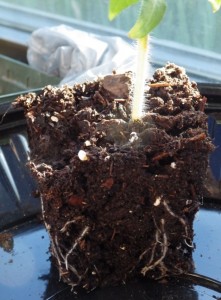 If you are just starting out growing plants from seeds on your own, you might have some questions about how quickly or soon to transplant to the next size pot.
If you are just starting out growing plants from seeds on your own, you might have some questions about how quickly or soon to transplant to the next size pot.
The secret here, to be blunt, is to concentrate on what’s going on AT THE BOTTOM; not what is happening at the top. As long as the roots are kept properly hydrated, they will keep the top growing. On the other hand, if the plant is stuck in water all the time, there will not be the proper exchange of oxygen in the soil and the roots will rot and the plants will die.
Roots are everything, truly.
So. The trick is to frankly pick up the pot or six-pack or whatever you are growing in and as soon as you see little white roots starting to stick out of the drainage holes in the bottom (you do have drainage holes in the bottoms of your pots, right?), it is time to transplant to a size up. If you have a lot of time between when you transplant and when you will be transplanting the plant out into the garden or out into its final growing place such as a large planter, a ‘grow-bag’ or whatever, you might even consider moving the plant into a container a couple of sizes larger than what it is in right now.
For example: The tomato plant in the photo at the top was in a four-pack (I’m not really a fan of ‘six packs’ – I feel I get more time and a better root system with a larger original growing container). Four-packs have a seedling space that is a cube of 2.25″x2.25″x2.25″. I have taken all of my seedlings that are four-packs (or single seedling pots of the same dimensions) and moved them into 4″ pots. This will give them enough space that if the rest of the spring continues for us here at Chez Siberia in the same way it has so far this spring (read that: cold and rainy), I will be giving myself some extra space and time so that the plants will not end up with roots all tangle around one another at the bottom of the pots, or running around the outside edge, which is not good for the plants in terms of when you plant them in the ground.
If you have seedlings or plants that have been in the pots too long and have become ‘root-bound’ like that, the thing to do (and I know it’s a little bit scary but it’s necessary) is to take a knife (or your hands) and either slice the rootball at the bottom in several places, spreading it out in the hole and then covering it with dirt, or tearing it apart with your hands and doing the same thing. To be quite blunt, yes, you ARE damaging the root system. The plant will respond by growing my roots from the ‘hurt’ spots and the plant will end up stronger and healthier as a result. If you just take the root-bound plant out of the pot and chucking it in the hole, the tangled and intertwined roots will never untangle themselves and the plant will not be able to achieve it’s growth destiny as a result.
So, if you pick up your seedlings and start to see roots, transplant them into something slightly (or more than just slightly) larger, give it a good drink and keep it going. Don’t just leave it in the pot to become root-bound. If you feel you will not have enough pots, then use household items such as milk cartons, yoghurt or cottage cheese containers (with holes punched in them) and so on. They will hold up nicely in the meantime and get your plants the space that they need until the weather is more conducive to putting them into the ground.
Make a muslin – jacket first try
 I always feel like one of those pictures in my junior high health textbook when I do these shots; all that is missing is the black bar across my eyes.
I always feel like one of those pictures in my junior high health textbook when I do these shots; all that is missing is the black bar across my eyes.
So, going from top to bottom, what are my issues here? And I say it that way because they are MY issues, not the pattern issues. The muslin went together smooth as silk; everything matched up. I know a lot of folks do changes on a tissue first before they cut out the muslin, but I don’t because I want to get a complete view of how the thing comes together. Once I start ‘slicing and dicing,’ all sorts of things can happen so I want to know how the garment came together before I do that. So, from that perspective, the pattern works really well. When I laid the whole thing out on the table after I’d sewn it together and ironed it, it literally looked exactly like the diagram on the envelop. (more…)
I hereby declare this month to be “MAMM”
OK, so this month out there is everything from “Me Made May” to “International Business Image Improvement Month” (which could use it, I admit) and I am going to totally avoid the entire thing and declare my own celebration: MAMM, which stands for:
MAKE A MUSLIN MONTH
I know there are folks out there who have been sewing since we were slapping laundry on rocks down by the old mill stream and avoid making a muslin of a new garment like the plague (and I suspect that most of them either have a sloper/block/tried and true pattern that they use religiously, OR they are perfect size whatever and have figured out which size in the Big Three fits them). I am not one of those people. I have physical issues that preclude whipping the tissue out of the envelop and just cutting out. I’m short, stocky, stout, short-waisted, broad in the back, have a tummy, big upper arms, and a rear-end you could set a potted-palm on. I also have arms like a T-rex (as in even petite size stuff is several inches too long in the sleeves) and low knees. I don’t like making ‘wearable muslins’ because by and large, this does not work for me; I end up with things that are too big in the shoulders with the waist in the wrong place, the armscye is way too low and the sleeves do not fit. And I will have ruined a piece of fabric; I’d rather work out all the issues on muslin first. (more…)
Best bang for your buck at the garden center
 Not everyone has the time, space, inclination or ambition to grow the flowering plants for their garden from seed on their windowsill. This leaves people buying their plants and sometimes these can get pretty pricy. I haven’t had the time or space to start my flower box plants this year, so the DH and I went to a local greenhouse to pick up a few things.
Not everyone has the time, space, inclination or ambition to grow the flowering plants for their garden from seed on their windowsill. This leaves people buying their plants and sometimes these can get pretty pricy. I haven’t had the time or space to start my flower box plants this year, so the DH and I went to a local greenhouse to pick up a few things.
I always find that getting plants in six-packs is a bit of a disappointment. The plants are so small that it takes a very long time for them to get big enough to fill in the space and make a show (which, of course, is the whole point, right?). So, to get enough plants to fill in, I end up buying probably 4 times the plants that I really have budgeted for – very expensive. Since I won’t be putting my plants into the boxes for another month then, it really pays me better to get a larger plant and split it. This is something anyone can do as long as you have some pots, potting mix, a sharp knife and some rooting hormone. You don’t need a greenhouse to do this; once you’ve potted up the cuttings, you can just stash the pots someplace in a bright room, out of direct sun. Keep the potting mix moist and you are all set. (more…)
Huipil-style, final thoughts
 Now, usually, your Aunt Toby is one to say, “In sewing, fit is everything,” but in a case where there is no ‘fit’ per se, fabric is everything. OK, in these two cases, it is not only fabric that determines the look, but also one other thing: One inch. Literally one inch in the width measurement makes a huge difference in the look. I did not think it would make that much of a difference, but it did.
Now, usually, your Aunt Toby is one to say, “In sewing, fit is everything,” but in a case where there is no ‘fit’ per se, fabric is everything. OK, in these two cases, it is not only fabric that determines the look, but also one other thing: One inch. Literally one inch in the width measurement makes a huge difference in the look. I did not think it would make that much of a difference, but it did.
First up – the top above, made of quilting cotton. The fabric was washed before I made it and I followed my formula from the last post – biggest measurement, divided by 2, plus 5″. This is also actually a couple of inches shorter, but no bother. I actually like the look better in this incarnation than in the next one, but I’m good with both, actually. Again, this top and this style top is going to have some action in my wardrobe this summer. Certainly the easiest thing to sew, EVER. No buttons, no zips. Each one of these (minus the time for washing, drying and ironing the fabrics and cutting the contrasting strips out) took a couple of hours and most of that was placing, pinning and sewing on the contrasting strips. Perfect ‘fiddle around in the evening’ project.
 Second up. This on literally is one inch bigger on the width measurement and a little longer. It is also made of cotton voile. Boy, what a difference that fabric makes, doesn’t it? On the other hand, it’s literally ‘light as a feather’ and will be great for wearing when it gets hot and sticky later. But I think I will take it in a bit at the sides for a little bit less ‘blousy’ look on me.
Second up. This on literally is one inch bigger on the width measurement and a little longer. It is also made of cotton voile. Boy, what a difference that fabric makes, doesn’t it? On the other hand, it’s literally ‘light as a feather’ and will be great for wearing when it gets hot and sticky later. But I think I will take it in a bit at the sides for a little bit less ‘blousy’ look on me.
A couple of thoughts:
In doing a bit more research on Frida Kahlo and her huipils, I found out that most of the decoration on these is actually very dense embroidery, which means that these were a real ‘economic development’ project for her – she bought the fabrics themselves but paid indigenous artisans to make them for her. These were not items which she just picked up in a shop or off a stall in Mexico City. I’m also fairly sure (though again, I’ve never seen one of these in person and so have not held one in my hands) that these weigh a good bit; all of that dense embroidery would require a fairly solid fabric to support it and between that and the embroidery itself, these were not lightweight tops.
Another thought is this: Am I, by using this concept and basic design, indulging in what is referred to today as, ‘cultural appropriation’? That’s a good question and one I continue to go over in my head as I go through these exercises on traditional clothing. I’m not trying to pass off what I’m doing here as a real huipil from the Tehuana region in Mexico; no one looking at them can be in any doubt of that. I feel also a tremendous amount of respect and honor for the artisans who produced the garments for Frida Kahlo to wear and who continue to produce them today. These garments, from skills and time they take in the weaving, embroidery and sewing, are worth every penny of the hundreds of dollars that are being asked for them (though I sometimes wonder if the artisans themselves are being paid that much for all their time and skill). But, from the viewpoint of ‘if I want to make a garment which is simple and sparing of fabric and resources’ standpoint, I think the huipil is an excellent basic traditional garment to use as a model.
Getting things started in the garden
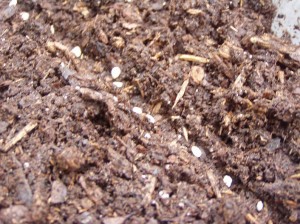 Well, spring really sneaked up on us here at Chez Siberia (and probably a lot of other places as well). One moment, we have six inches of snow with freezing temperatures and the next… 50 degrees and sunshine.
Well, spring really sneaked up on us here at Chez Siberia (and probably a lot of other places as well). One moment, we have six inches of snow with freezing temperatures and the next… 50 degrees and sunshine.
Nothing like that to wake up the ‘we’d better start the tomatoes’ feelings.
Now, all long-range weather forecasts are telling your old Aunty that this summer is going to be not very warm (of course, all things are relative) – they are calling for temperatures in July and August to be 5-10 degrees cooler than normal. Which means that I needed to choose tomatoes that have a note on them saying something like, ‘cold tolerant’ or ‘will set fruit even in cooler temperatures’, because tomatoes are one of those tricky beasts. Most of them require warm night-time temperatures to set fruit. If temperatures are going to be iffy, then this is the way I hedge my bets.
Starting tomato seeds is really pretty simple. You need all the usual things – seed starting mnix, something to put it in, some warmish water, the seeds and a source of bottom heat. I use a heating mat, but I also got a metal grill to put on top of it to hold the box above the wwarmth a little bit. If I put the box of soil right on the mat, the soil mix gets to a temperature of over 80 degrees. Yes, I want warm soil but that will cook the seedlings, so I hold it away. If I didn’t have a metal grill to raise the box, I’d put an old towel on top of the mat to do the same thing. I also am a keen re-user of those plastic boxes that you can get salad mix in at the grocery store. They are relatively sturdy and have a lid that snaps on tightly to hold in the warmth and the moisture for the early stages of growing the seedlings until I need to transplant them out into bigger pots.
Now, this really is something you can do on the window sill at home as long as you have a sunny window, though you do need to keep watch to turn the seedlings so that they don’t grow all in one direction. I have an unheated greenhouse (and right now the temperature in that is 36 degrees – once the sun comes around the corner of the house, it will go up nicely into the 70+ range), but between the warming mat and my covering up the box with a big clear plastic bag, the soil is warm enough to keep the seedlings going.
Something that I am doing new this year (and I realize this sounds a bit daft at this point in the game) is that I am not putting any sort of seed identification markers IN the box. I’ve actually ended up numerous times with mold and other issues inside the box with the wood tags that I’ve used, so I’m doing something different this year. The humble piece of masking tape on the outside of the box.
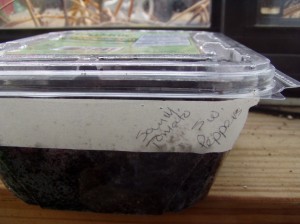 I figure I can just write on the tape and won’t have as many issues inside the box until it is time to transplant.
I figure I can just write on the tape and won’t have as many issues inside the box until it is time to transplant.
Speaking of temperatures (digression), this year’s long winter and very cold temperatures have set me way back. Usually I can get out, put clear plastic or glass over one of the beds and get the soil up to 50 degrees so that I can put in cabbage, broccoli, cauliflower, Chinese cabbages, beets, chard and lettuces. Not this year. I went out this week and took the soil temperature and it was still under 40 degrees F. Not warm enough for me to encourage it with a piece of glass or plastic, I’m afraid. I’ll try taking the temperature again today since we’re supposed to have a nice warm sunny day (again, all relative; it’s supposed to be 50 degrees F). Perhaps I’ll have better luck today.
In other areas of the garden, we’re starting to see the leaves from some of the many bulbs I planted in the fall. The crocuses are up, bless ’em, but nothing else so far. It will be very interesting to see how the bulb patch looks once it’s in full flower mode. The patch, frankly, is a supremely ugly spot under which is our new septic system. So, of course, in the digging, installing, and filling in, we lost all of the top soil (despite our begging the contractor to set it aside on a tarp that we oh-so-thoughtfully put out for him) and have nothing there but horrific weeds which we have been assiduously yanking out and replacing with hardy perennials, in the hope that they will beat the nasty guys back (I know, wishful thinking). In the fall, I planted several hundred bulbs of various sorts and we shall see if that gives us a little bit of pleasure in the next couple of months.
Hope your spring gardening is coming along! Anything new and exciting in your garden?
The Pillow Project: Zips, Snips, and Done
 So, let’s get down to business, shall we?
So, let’s get down to business, shall we?
First things first: How are we going to close up the pillows? Well, yes, I can leave one edge completely open, stuff in the pillow form and then whipstitch it closed. Which I hate because it frankly requires me to keep the pillow form under some sort of control while I’m doing it. Very tiresome. I could also do a double flap and put in buttonholes and buttons. But I’m not going to do that either; I’m just going to put in a zipper. This makes stuffing the pillow very easy and it’s a neat and tidy closure. There are two ways to do this – in one of the seams (and if you follow directions on the package the zipper came in, then you are home free). Or, I can split the back into two pieces, make a seam there and insert the zipper in that seam. (more…)
The Pillow Project
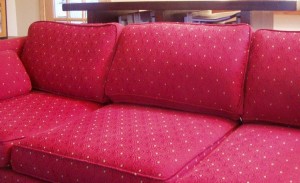 I think I can safely say at this point that even at Chez Siberia, it’s spring. Most of the snow is gone and I’m seeing the little leaves of the spring bulbs start to poke up.
I think I can safely say at this point that even at Chez Siberia, it’s spring. Most of the snow is gone and I’m seeing the little leaves of the spring bulbs start to poke up.
Not that it is warm by anyone’s stretch of imagination. It’s 22 degrees F. this morning and windy so it’s not warm. But we are seeing the proverbial ‘light at the end of the tunnel’, winter-wise, here. Which means only one thing.
Dissatisfaction.
After being cooped up for almost 5 months (and given the series of storms, horrific cold, wind and so forth; that 5 months seemed to last forever), there is part of me that requires massive change. Ordinarily, this revolves around getting my hair cut but this time, it’s more global. (cue scary music) I need change in the house.
Change in the house usually requires painting (which I don’t want to do; I actually like the color in the house at the moment). Some people go for a giant ‘slip-cover-a-thon’ for the furniture or a big change-over in the drapes. And not that I could not be convinced to change out the drapes in the livingroom for spring/summer/fall. I actually think that might be a good idea (something light-colored perhaps), BUT from a budgetary standpoint, I always go for ‘biggest bang for the buck’, which I think in this case involves… cushions for the two couches in the livingroom.
Above you see one of the couches. We have this one and a dark blue one and a red and blue and ‘some other colors that I’m not quite sure I can identify at the moment’ rug to tie everything together in the livingroom. I certainly lay no claim to great expertise in home decor. We tend toward the ‘find a hole and fill it’ school of decorating, especially on the walls. But after living with these couches for five years (one is an ancient one we inherited from one of my great-aunties which went through a complete re-do from the inside out), I have to say one thing:
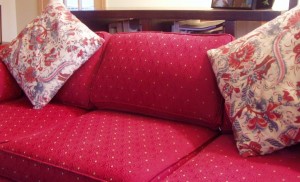 They look a lot better with cushions on them and they look a whole lot better with cushions that are highly contrasting. At the moment, cushions are a bit ‘thin on the ground’ as they might way.
They look a lot better with cushions on them and they look a whole lot better with cushions that are highly contrasting. At the moment, cushions are a bit ‘thin on the ground’ as they might way.
Hence the title above: The Pillow Project
Pillows, as a home decor project and as a sewing project are about as simple a deal as you can possibly find, as long as you measure the pillow insert correctly. If you want to be very technical, you can make cushion covers with zippers in them, or you can devise an opening that is held closed with buttons (meant to be seen, or not) or with a clever use of folded fabric at the back, like an envelop. But I need to make, as they might say out West, a ‘whole mess’ of cushions. I might even change out the cushion covers I already have (just to put something else into the rotation. So far, the plan includes printing cushion covers and fabric with screen printing. I might even use fabric paints on the fabrics and come up with my own fabric as well. This is an opportunity to let my creative ‘freak flag fly’.
So, stay tuned.
